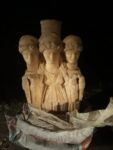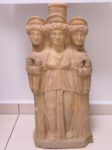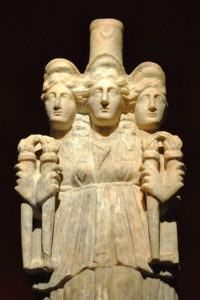 Police have recovered a striking Roman-era marble statue during a smuggling bust in Turkey’s southwestern Denizli province. Two vehicles were being followed as part of a police investigation into antiquities smuggling. Anti-smuggling and anti-organized crime police units pulled the cars over, searched them and the statue was discovered inside one. Four individuals were detained on suspicion of violations of the Protection of Cultural and Natural Heritage Law.
Police have recovered a striking Roman-era marble statue during a smuggling bust in Turkey’s southwestern Denizli province. Two vehicles were being followed as part of a police investigation into antiquities smuggling. Anti-smuggling and anti-organized crime police units pulled the cars over, searched them and the statue was discovered inside one. Four individuals were detained on suspicion of violations of the Protection of Cultural and Natural Heritage Law.
 The reports in the press are meager with little in the way of detail. The sculpture is sketchily described as three-headed statue of a beautiful woman with torches and wings, but I don’t think that’s accurate. For one thing, each head has its own body, albeit squared at the side. You can tell from the Doric chiton they each wear that it’s three individual figures, not a single three-headed lady. The central female figure
The reports in the press are meager with little in the way of detail. The sculpture is sketchily described as three-headed statue of a beautiful woman with torches and wings, but I don’t think that’s accurate. For one thing, each head has its own body, albeit squared at the side. You can tell from the Doric chiton they each wear that it’s three individual figures, not a single three-headed lady. The central female figure  holds a torch in each hand, the side figures hold torches in one hand. The reliefs on the back described as “wings” just look like their second arms to me. They’re very roughly hewn with the draping lines indicating the short sleeves and Playmobil style gripper hands, so I can see why someone might consider them winglike.
holds a torch in each hand, the side figures hold torches in one hand. The reliefs on the back described as “wings” just look like their second arms to me. They’re very roughly hewn with the draping lines indicating the short sleeves and Playmobil style gripper hands, so I can see why someone might consider them winglike.
This is a triple Hecate. Hecate was a protective deity, guardian of gates and crossroads, often depicted holding double torches and as a threesome, handy when you’re keeping watch over all lines of approach. Pausanias, in his 2nd century travelogue Description of Greece, claims that the 5th century B.C. sculptor Alcamenes was the first to create a triple statue of Hecate. If so, he started a trend that would outlast ancient Greece and Rome and still be going strong in artistic motifs by the likes of William Blake.
The worship of Hecate was widespread in Thrace and Anatolia. It may have even originated there and spread to Greece later. Hecate was a particular favorite of the ancient city of Byzantium who would become in its later Roman incarnation the capital of one empire, then the capital of another and is today the city of Istanbul.
Philip II of Macedon, father of Alexander the Great, flush from a number of military successes, turned his attention to the Hellespont in 340 B.C., and besieged the city of Perinthus on the Sea of Marmara west of Byzantium. Perinthus, perched on a high slope with strong walls and stone houses jammed close together to act as a secondary barrier once the walls were breached, defended by the allied forces of Athens and constantly resupplied by Byzantium, proved too tough a nut for Philip to crack.
Hoping to choke off Perinthus’ support and take advantage of the absence of many of Byzantium’s troops, weapons and war machines, Philip peeled off half his army from the siege of Perinthus and hit Byzantium. His strategem failed. Neither city fell and Philip was forced to make a truce with them and their allies. Plutarch attributes Philip’s loss to skill of the Athenian general Phocion. Diodorus Siculus chalks it up to Philip giving up when a bunch of other Greek cities sent reinforcements to break his sieges.
The account of 6th century chronicler Hesychius of Miletus, on the other hand, posits a less terrestrial explanation for Philip’s defeat. It was a dark and stormy night. The moonless sky was a perfect setting for a sneak attack by Macedon’s troops. All of a sudden, a bright light illuminated the heavens and the city’s dogs barked loudly. Byzantium’s defenders awoke and fended off Philip’s soldiers, defeating the Macedonian decisively. The great light was the work of Hecate protecting her most devoted adherents with the aid of the animal most sacred to her, the dog. The dramatic end of the siege was commemorated with a great statue overlooking the Bosphorus of Hecate Lampadephoros, the lamp-carrier.
 Triple Hecates have been found throughout the Roman Empire, and Turkey, which has a solid claim to the origin of the cult, is certainly no exception. There’s a beautiful example in the Archaeological Museum in Antalya 140 miles southeast of Denizli. It’s very similar to the one recovered by the police, only the recent discovery lacks its handsome proportion and attention to detail. It’s the budget option, basically.
Triple Hecates have been found throughout the Roman Empire, and Turkey, which has a solid claim to the origin of the cult, is certainly no exception. There’s a beautiful example in the Archaeological Museum in Antalya 140 miles southeast of Denizli. It’s very similar to the one recovered by the police, only the recent discovery lacks its handsome proportion and attention to detail. It’s the budget option, basically.
The confiscated statue is now in the hands of archaeologists at the regional museum who will study it further.
It was a dark and stormy night, a heavily laden car stops at a junction, and the sky lights up in flashing blue. You’re nicked, nicked, nicked!
This ‘one’ appears to be the face, boobs and legs version.
It’s the budget option, basically.
… or yet another crude fake that the Turkish police are so adept at ‘recovering’?
(Click on my name for a brief look at another example of their ‘recovery’.)
I’m fascinated at the black market for ancient treasures.
But it’s so old and difficult to know for sure if it’s real like David said.
Recently I learned about Egypt’s king Tut statue being auctioned off but the Egyptian government wanting it back… It’s quite political isn’t it?
Interesting, thanks!
When I see those fake books, I am reminded of those adventure books from the thirties, where the adventurers always seemed to end up in a dark and smokey temple, full of dark and swarming heathens, trying to steal the diamond from eye of the dtone god.
It is like many people want to believe in the same romance of dark and smokey pasts in far distant lands.